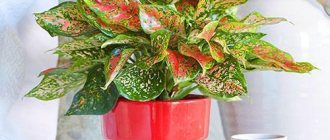Home » Indoor plants » Decorative foliage plants
Published: 10/31/2018
Codiaeum belongs to the Euphorbiaceae family. Native to East India, Malaysia, Sunda and Molluk Islands. Its peculiarity is the presence of milky juice, which soaks the stems and leaves, helping the plant heal any damage and infections. Flower growers often use another name - croton.
- 1 Description
- 2 Varieties for indoor breeding - table
- 3 Home care 3.1 Seasonal table
- 3.2 Transplantation: pot, soil, step-by-step description
- 3.3 Formation, support
Varieties for indoor breeding - table
At home, of the entire species diversity of croton, only one is grown - verigate (variegated), but the varieties bred on its basis are not inferior in color originality.
| Varieties | Leaves and other features |
| Variegatum | Large, length - 30 cm. A variety of shapes of leaf plates from a yellow-green color scheme, varying depending on lighting and other factors. The stem is straight, without foliage below. This is the founder of all decorative hybrids. In the house it grows up to 70 cm. |
| Petra | Thick, shiny, light green in color with yellow edges and veins. The shape is similar to pointed blades. The stem is branched. |
| Tamara | Elongated oval with uneven edges, unusual coloring - pink, purple or yellow spots are scattered on a white-green background. Hybrid. It reaches a height of one meter. Rare variety. |
| Mammy | Twisted, long, curly, variegated in color. |
| Mrs Eyeston | Long, wide, rounded at the ends, brightly colored - yellow, red, pink and gold. Tall tree variety |
| Black Prince | So dark green that they appear black. Red, yellow, and orange spots are scattered on wide dark ovals. |
| Excellent | They resemble oak trees, the front side is yellow-green, the back is burgundy-red. Low bush. |
| Disraeli | Lobed green, veins yellow, bottom brick-brown. |
| Zanzibar | Very narrow and long, falling like a green, yellow, red waterfall. Looks impressive in hanging baskets. |
| Aucubifolia | Small narrow, green with yellow uneven splashes. |
| Sunny Star | Narrow, dark green, blooming at the tips with yellow and lemon hues. |
| Three-cavity | Consist of three parts with gold veins. |
| Eburnaeum (white chimera) | Creamy shade. With bright diffused lighting and constant spraying, it can please you with burgundy colors. |
| Splashes of champagne | Narrow oblong, dark with yellow splashes. |
The mix is a varietal variety of croton.
Location
Croton is a light-loving plant, and the variegated color of its leaves largely depends on the lighting. But prolonged exposure to direct rays is contraindicated for the flower. Therefore, when providing proper care for Croton at home, focus on the weather and time of year.
In spring and autumn, an eastern or western window sill will be the ideal place for a flower. In summer, move the pot to the northern part or move it deeper into the room. In winter, on the contrary, place the flower on a southern windowsill or illuminate it with a phytolamp.
Croton needs fresh air. At any time of the year, do not forget to ventilate the room, but protect the flower from drafts - it absolutely cannot stand it. Therefore, during ventilation, take your pet to another room. In summer you can keep the plant on the balcony. But choose a place with diffused light for the flower.
Home care
The plant is quite finicky, but if you create the right conditions, you can achieve diversity and brightness throughout the year.
Seasonal table
| Parameter | Spring Summer | Autumn winter |
| Location/Lighting | Prefers eastern and western windows with bright but diffused lighting. | It is best to choose a south window. With light starvation, the leaves will begin to lose their bright color; lighting is necessary. |
| Temperature | Comfortable - +20…+24℃. At +30℃, shading and increased humidity are necessary. | Avoid temperature changes. Acceptable - +18…+20℃, not lower than +16℃. |
| Humidity | Increased. In summer, constant spraying with warm, settled water. It is good to place the container with the flower in a flowerpot with a damp filling (pebbles, expanded clay). | Spraying is reduced. But during the heating season, it is necessary to monitor the saturation of moisture in the air near the codiaum. |
| Watering | Frequent, good. But the soil should dry out to a third of the container. The water is warm and settled. | Reduce. |
| Feeding | Once a week - alternating complex mineral and organic fertilizers | Reduced - 1 time per month. |
Transplantation: pot, soil, step-by-step description
Codium is transplanted in the spring. Young (1-3 years) - annually, adults (over 3 years) - once every 2-4 years.
The pot should be shallow, slightly wider than the container in which the flower was before transplanting. Since its roots grow, they interfere with the development of foliage. For young croton, you can use plastic, but for older croton, a clay ceramic pot is preferable so that the soil inside can breathe.
Drain holes are required.
The soil needs to be slightly acidic. The finished universal soil is diluted with fine-grained drainage, perlite and charcoal. Self-cooking:
- young growth: humus, turf, coarse sand (2:1:1);
- adult croton - (3:1:1).
Transplantation is a step-by-step process:
- The soil is pre-watered.
- The new container is filled with drainage (three centimeters) and a small amount of soil mixture.
- Using the transshipment method, they take out the codiaum, place it in the middle and add soil.
- Watered.
- Place the flower pot in a place with sunny but diffuse lighting. Moisturize daily.
It is better to replant a new flower after a month.
To improve the adaptation process, croton is sprayed with a growth stimulator (Epin).
Formation, support
To create a more luxuriant crown, young plants are pinched. At the beginning, 15 cm, as it grows - 20 cm. Pruning is carried out in the spring.
If after the procedure the codiaum stops growing, this is a temporary phenomenon. After some time it will branch.
For an adult croton, with a lot of foliage and an insufficiently strong trunk, support is needed. In the beginning, you can use bamboo or wooden sticks. You can also purchase special devices for vines, or make them yourself.
Watering
Frequent but moderate watering is the basic rule of home care. Croton, the photo of which is given in the material, loves moist, but not wet soil. And stagnation of moisture at the roots leads to rotting and even death of the flower. Therefore, take watering seriously.
Make sure that the soil does not dry out to a depth of more than 2 cm, and always drain excess moisture from the pan. On average, you need to water a flower every other day in summer, and in winter it is enough to moisten the soil once a week. In general, be guided by the conditions in your apartment. For watering, use soft, filtered water at room temperature, standing for at least a day.
Errors in care and their elimination - table
Croton's appearance will indicate improper conditions of detention and mistakes in caring for it.
| Type of lesion | Reason for appearance | Elimination method |
| The foliage is turning pale. | Lack of lighting. | Place close to the light, but protect from bright sunlight. In winter, use artificial lighting. |
| Dry brown specks. | Sunburn. | Hide from sunlight. |
| The leaves are curled, the ends are brown but soft. | Temperature changes. | Monitor the temperature during the day and at night. It shouldn't be drastically different. |
| Brown and brown edges of leaves. | Lack of watering. Dry air. Drafts. | Provide everything:
|
| Drooping leaves, loss of elasticity. | Lack of watering. Freezing of roots. | Water regularly with warm water. Place in a bright and warm room. |
| Leaf fall. | Croton is getting old. Excess moisture in winter. Very dry or cold atmosphere, drafty. | Follow the codeum: With normal growth of young leaves, this is a common occurrence. If young growth is suffering, eliminate all shortcomings. |
| Redness of the leaves. | Nitrogen starvation. | Use fertilizers containing nitrogen. |
| The back of the leaf becomes white and fluffy, the top becomes brown. | Temperature too low. Overwatering. | In winter, if there is a lack of heat, water with warm water after the soil has dried to one third of the volume of the pot. |
| Yellowing. | Lack of nutrition. Overwatering. | Apply fertilizer as it grows. Follow watering rules. |
| Red spots on the back of leaves. | Excess sun. | Shade in midday sun. |
Top dressing
Without additional feeding, codiaum leaves quickly lose their variegated color, which affects the decorative appearance of the plant. Therefore, regular application of fertilizers is an important rule of care. Feed Croton from late March to early November twice a month with liquid solutions of complex mineral fertilizers. Carry out this activity strictly after watering. Otherwise, fertilizers will burn the roots of the flower.
In winter, the plant enters a dormant period, so at this time the flower does not need feeding. As a last resort, apply fertilizer no more than once a month.
Diseases, pests - table
| Manifestation | Disease, pest | Fighting method |
| The appearance of brown spots. Codiaum does not grow and dries out over time. | Fungal disease | Remove diseased leaves. Place the codiaum in a weak solution of potassium permanganate. Replace the soil. Treat Croton with Fitosporin solution. In case of severe damage, use Speed. |
| Yellowing and falling leaves, softening of roots. | Root rot | Only at the beginning of the disease is it possible to save croton:
Protected light and infrequent watering are required until new leaves appear. |
| The appearance of yellow spots, white cobwebs. The leaves are withering. | Spider mite | Remove diseased leaves. Spray with Fitoverm, Actellik. |
| Convex, dark spots on the back of the leaf. | Shchitovka | Remove the pest. Spray with Actellik. Repeated treatment until the insect disappears. |
| The leaves are sticky, a whitish coating appears, and growth stops. | Mealybug | Treat with insecticide repeatedly. |
Propagation by seeds
This propagation method is not popular among plant growers. After all, growing croton from seeds takes a lot of time. In addition, flowers propagated in this way do not retain varietal characteristics.
If you don’t mind experimenting, then start the event in January-February. Please note that croton seeds quickly lose their viability. Therefore, for germination, use fresh grains collected this year. Before planting, be sure to prepare the seed material. To do this, keep the seeds for half an hour in water at a temperature of +60 °C. And then soak them for a day in warm water with the addition of any growth stimulant.
Plant the prepared grains in moistened, universal soil for seedlings to a depth of 0.5-1 cm. Please note that before sowing you need to warm the mixture to +22 °C, and then you should maintain it in this condition. Therefore, you can’t do without bottom heating. After planting, stretch glass or polyethylene over the container or pot and place the improvised greenhouse in a warm place.
Regularly moisten the soil, preventing it from drying out, and use the bottom watering method. That is, place the greenhouse for a while in a basin filled with warm, settled water. And also do not forget to wipe off condensation from the shelter. Maintain the temperature near planting within +22-25 °C. Only under such conditions will croton seeds germinate at home.
Is the plant poisonous?
Croton is poisonous. When its juice enters the stomach, all the signs of food poisoning appear.
All work with codiaum should be carried out with gloves, and then wash your hands thoroughly with soap.
Croton is an amazingly beautiful, but capricious plant. With proper care and attention, it will decorate your home for many years with its unusual variegated foliage. To understand what a flower lacks, pay attention to its condition. You just have to be patient and you will definitely make friends with this handsome guy.
What to do when ornamental foliage plants bloom.
Most often, various sources recommend removing the flowers of decorative foliage plants. This is necessary so that the plant is not weakened by flowering. Yes, indeed, there is a possibility that some representatives of the plant world may lose their decorative qualities. But. There are no laws or obligations in indoor floriculture. If you want your croton (sansevieria, schifflera, etc.) to flourish, let it do so. Your plants are your rules.
Seasonal conditions of detention (table)
| Season | Humidity | Temperature | Lighting and placement |
| Spring | If we remember that croton is an inhabitant of tropical forests, then we can immediately conclude that the plant needs increased humidity. But not excessive. The threshold is 45%; a decrease in humidity will immediately lead to unpleasant consequences. In summer, be sure to spray the leaves with water heated in the sun. In the summer heat, you need to increase the humidity around the plant. To do this, place the pot in a shallow container filled with wet pebbles or expanded clay. | Croton loves warmth, but does not tolerate heat. The average temperature in summer should be 20 - 24°C. If the thermometer approaches the 30°C mark, the plant needs to be shaded and the humidity around it increased. | The plant loves bright light and needs it. But it gets burned from direct sunlight, so it requires shading. East and West directions are larger |
| Summer | |||
| Autumn | In autumn and winter, the leaves are sprayed with warm water, but not as often as in the summer. The situation will change only when the heating system is turned on. During this period of time, the air should not be allowed to dry out. | Winter temperatures are from 18 to 20°C. This indicator must not fall below 16°C. It is worth noting that croton really does not like temperature changes. | In winter, croton is not afraid of the sun's rays, so it can be moved to a southern windowsill. As light intensity decreases, green colors will begin to predominate in leaf color. Reduced daylight hours and cloudy weather are reasons for additional lighting. |
| Winter |
Growing problems
With frequent care mistakes at home, the croton begins to act up. In some cases, flower growers face the following problems:
- The leaves of the flower fall. If the trunk becomes exposed from below, then do not worry, because this is a natural process. If the plant loses its top leaves, it means that you are keeping the flower in a too cool room or the croton is suffering from a draft.
- Leaves change color. This phenomenon indicates that the pet does not have enough light. Move the pot closer to the window or provide additional lighting with a phytolamp. And the croton will restore its variegated color.
- Brown spots appear on the leaves. Such damage causes sunburn. To correct the situation, move the flower to a room with diffused light. As a last resort, hang tulle or gauze over the pot during the midday hours.
- Croton dropped its leaves. A similar phenomenon is caused by a lack of lighting. Irregular watering can also cause leaves to droop. If the soil is too dry, do not flood the plants, but gradually increase the moisture. Otherwise, too much watering will lead to rotting of the roots.
- Codiaum leaves are drying. The main reason for this phenomenon is insufficient air humidity. To correct the situation, spray the flower more often. If brown spots also appear on the drying leaves, it means that you water the flower with cold water or keep the pot on a cool windowsill.
- The plant is not developing well. This is caused by a lack of light or poor soil composition. To correct the situation, move your pet closer to the window, and do not forget to regularly feed the flower.
Croton transplant
To transplant croton, use shallow and wide containers. The drainage layer (at the bottom of the pot) must be at least 3 centimeters; for this you can use expanded clay, broken brick or ordinary fine gravel. The pot itself must be placed in a tray with gravel, which will always contain water. This will permanently maintain the moisture of the earthen coma.
Plants are usually planted or replanted in summer or spring. Croton should be placed in a small hole in the soil so that its root system does not touch the drainage layer.
Young crotons require
annual replanting; it should be done in summer or spring.
Mature plants require replanting as the root system fills the pot. In this case, the volume of the new container should not greatly exceed the volume of the old one, and the diameter should be 3-5 centimeters larger, and before replanting it is necessary to add high-quality fertile soil to the pot. You should not replant croton if you do not know exactly how to do it in a timely and correct manner; this can only harm your plant or even ruin it. By pinching off the top shoot of the plant, you can give it the shape of a bush, although its natural crown shape is that of a small tree. However, you should not count on rapid crown formation, since the side shoots grow much slower than the stem.
Why does croton bloom? What plants can bud.
Most indoor flowers in botany are classified as angiosperms or otherwise flowering plants. That is, almost any of your home green friends can bloom. Except, of course, ferns. Therefore, there is no need to ask the question: why does Croton or Schifflera bloom? The appearance of buds is normal behavior for plants. In general, a flower is primarily a reproductive organ. You need to understand that plants are living beings. They must have the ability to reproduce. Some have flowers, others have sporangia or cones (like pine trees). Even the ficus trees are blooming. Their flowers are located inside a special organ - syconium.
Arrowroot flowering
Reviews
Croton is popular among users. According to reviews, this plant is unpretentious and even a novice gardener can care for it. In addition, codiaum has a thick and bright crown that complements any interior. And with proper care at home, croton practically does not get sick.
In general, the attractive croton will decorate your collection of home flowers, because it is decorative and grows quickly. Moreover, growing the plant is not that difficult. The main thing is to follow the recommendations and provide proper care for Croton at home.
What are decorative foliage plants?
In indoor floriculture, the term “decorative foliage plants” refers to those flowers that are grown for the beauty of their foliage. This concept does not exist in botany or any other science. Please note: it is written not just “deciduous”, but “decorative deciduous”. It is important. Because the name “decorative foliage” includes the area of application, i.e. for apartment decoration. And the term “deciduous” indicates that the plant has leaves. But you must agree: Saintpaulia (for example) also has foliage, but at the same time it is definitely not considered decorative deciduous. Therefore, it is better to use common names rather than try to shorten them. After all, this distorts the original meaning.
How to care for seedlings
The first seedlings will emerge a month after sowing. Once this happens, start hardening off the plants. To do this, remove the cover from the greenhouse first for an hour, then for two and gradually increase the time.
Until the seedlings get stronger, keep them in a lighted place out of direct sunlight. If the weather is cloudy, be sure to illuminate the sprouts with a phytolamp. Do not forget to regularly spray the soil with warm, settled water from a spray bottle.
When the seedlings have 2-3 leaves, carefully pick them into individual containers, being careful not to damage the delicate roots. Select the soil as for adult plants. More information about the substrate is written in the chapter “Transplantation”.
Propagation by cuttings
This propagation method is quite simple and even a novice gardener can handle it. Moreover, the event can be held at any time of the year, except January - February. During this period, the croton rests. And the planted cuttings will grow roots poorly or, in general, will rot.
For propagation, select woody twigs from the top of the plant. Each cutting must have at least one strong bud and a pair of leaves. It is desirable that the length of the workpieces reach 10–15 cm in length. It is better to root cuttings in water. But before that, wash off the milky juice, dry the branches for 2 hours in a bright, warm place, and carefully tie the leaves into a tube. This way, you will prevent the rapid evaporation of moisture from croton leaves. How to care for cuttings at home:
- Keep the branches in water with a temperature between +25-30 °C. If you want to speed up rooting, add a root formation stimulator to the liquid, for example, “Kornevin” or “Epin”.
- Place the container with cuttings in a bright place where direct rays of the sun do not reach.
- Maintain the room temperature +22-25 °C.
- Add fresh, warm water to the container as it evaporates.
As a rule, rooting of cuttings takes 1–2 months. When the shoots reach 2–3 cm in length, transplant the plants into individual pots. For the first two weeks, keep them in a warm place with indirect light and high humidity. In the future, provide the usual care for croton flowers at home.
Myths and superstitions.
As a result of the lack of reliable information, people tend to “make up” their explanations. Agree, most flower growers do not need to know the nuances of botanical classifications and other subtleties for life. But it happens that lack of knowledge leads to absurd conclusions. For example, rich imagination associates the flowering of decorative foliage plants with misfortunes or even the death of loved ones. Unfortunately, even reputable publications and resources miss unverified information. Therefore, these myths constantly wander among flower growers. But you can't go against nature. Reproduction is a natural need of living organisms. If the conditions for flowering are created for a plant, then it will flourish. And to consider that plant propagation is evidence of some failures of the grower is probably unacceptable in our age of high technology.
Sansevieria blooming











